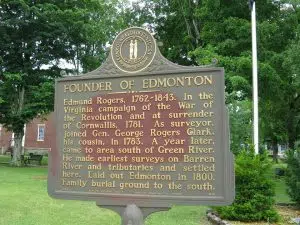By JENNIFER MOONSONG
Glasgow News 1
Revolutionary War Soldier Edmund Rogers, who was born in Virginia in 1762, had already lived much life before he arrived in what was to be known as Barren and Metcalfe counties.
In 1781 at the tender age of 19, he volunteered to be a soldier. Rogers was there when the famed British General Cornwallis was cornered by the French army and fleet, and Washington’s Continental army. Following the war, he received a land grant from Gov. Patrick Henry along with hundreds of others who served, and it was that grant that brought Rogers to Kentucky.

Edmund Rogers surveyed much of the land in Barren, Metcalfe and Green counties following the Revolutionary War.
Barren County Historical Society
A descendant of William Clark, of the Lewis and Clark Expedition, it comes as no surprise that following the war, Rogers worked on expeditions to survey lands the rest of his days.
Rogers’ work as a surveyor began in 1783 in what was then known as “Clark’s Grant,” a swath of land north of the Ohio River Valley. The next year, Rogers’ tasks were designated differently. This time, he was to survey military properties south of the Green River. He settled in the region in what is now Edmonton, which is named for Rogers.
Surveying the untamed wilderness regions of Kentucky was a dangerous job that exposed surveyors to the elements, animals and sometimes Native Americans who were dwelling along the creeks of Kentucky. Rogers’ kept journals of his adventures and write these words on the subject:
“I was occasionally compelled to abandon my operations on account of signs and Indian attacks. On one occasion when in hot pursuit of my survey crew they overtook and killed one of our company. I impute my escape alone to the time occupied in dispatching the unfortunate individual who fell into their hands.”
Rogers is noted in colloquial history and some written texts, to believe it was fate that brought him to the Kentucky wilderness, and fate that made him fall into a river, causing him to meet his wife, Mary Shirley, known belatedly as “Polly.” They married in 1809, and Rogers wrote this about their meeting:
“It was while surveying land that I met Mary Shirley and it was all the cause of falling off a log. It happened on a day when I left Pittman Station to go into the wilderness south of Green River. I had been attempting to cross a creek, when I slipped off the log and fell into the creek. I got my papers wet and was induced to return to the station to dry them, and then to take a new start. Upon my return I met with a stranger who had a large number of warrants and I made a contract with him for the locations. Under this I secured the land around Edmonton. If I had not fallen into the creek I would not have turned back. If I had not returned to the station I would not have made the contract by which I obtained the land on which I settled, if I had not got the land I should not have lived upon it. If I had not lived there, I would have been thrown into a different society and most probably would never have seen the lady I married and, of course, would not have had the life and children I have and of further consequence, the very existence and destiny of those children and their descendants through all coming generations and the influence they may exercise in families, neighborhoods and counties depended upon me falling from the log.”
Rogers and his wife Polly had eight children, and lived in portions of Barren and what later became Metcalfe all their days. Many of the creeks and settlements of Barren, Metcalfe ad Green, including Nobob Creek in southern Barren, got their names from Rogers’ survey crews.
Rogers died in 1843 at the age of 81. His last will and testament are still recorded in the Barren County Clerk’s office.
According to an account of his death, he was seen smiling not long before he died, and when he was asked why he made the reply, “I was thinking of the vain efforts of three of the best physicians in the county to save the life of an old man when his time had come.”
The information from this Flashback Friday was extracted from WKU’s extensive Folklife Archive.

One of many historic markers in the region, this one details the life of Edmund Rogers.
Submitted

Comments